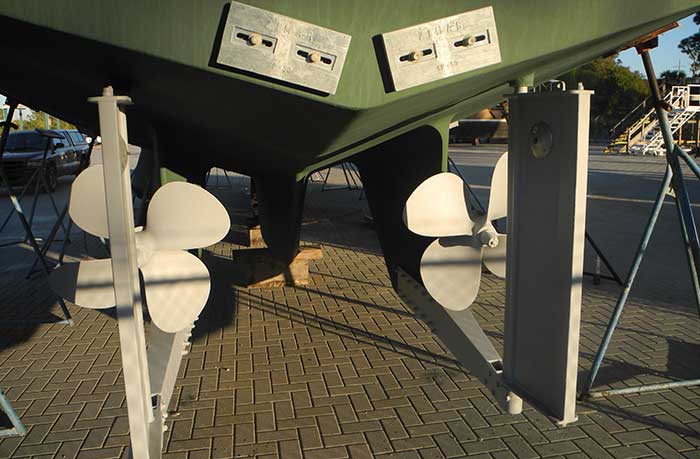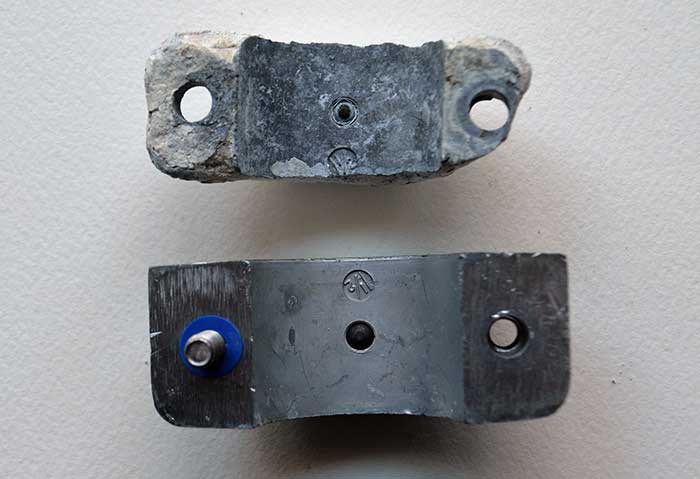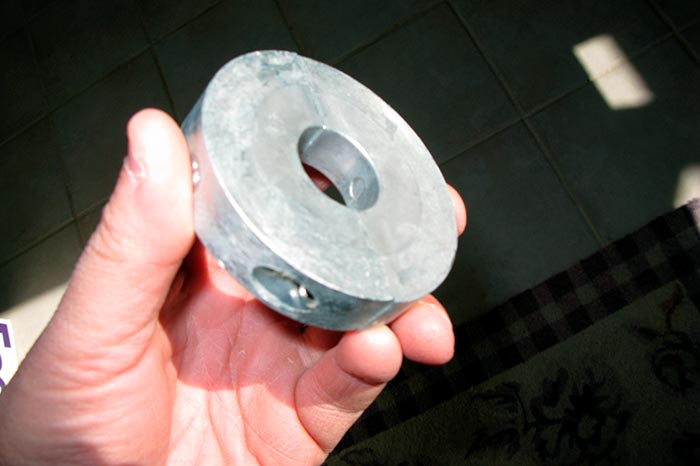Advertisement
There are several ways to stop your underwater hardware from becoming the loser in your boat's attempt to make electricity.

Without the proper anodes, your boat's underwater metals are at risk of severe damage from corrosion. (Photo: AskCaptainChris.com)
In the late 18th century, Luigi Galvani (where the word "galvanic" comes from) discovered the principles of battery operation. Later, in 1800, Alessandro Volta (as in 12-volt) made the first battery, out of alternating plates of silver and zinc separated by paper soaked in saltwater, and created a useful electrical current. What does all this battery stuff have to do with anodes and protecting metal on your boat? Plenty. Galvanic corrosion — the type that can destroy underwater metal in your boat — is simply a giant battery cell that has been set up somewhere on your boat's hull.
When Is A Boat A Battery?
As Volta discovered, a battery is composed of two dissimilar metals that are electrically connected to each other and surrounded by an electrolyte (saltwater or acid, for example). In the case of a boat moored in seawater, a stainless-steel prop connected to an aluminum outdrive floats in the world's biggest electrolyte and — presto! You have a giant battery.
The energy created is not sufficient to do anything useful. The more significant problem, however, is that in this giant battery cell, one of those dissimilar metals, for instance the aluminum outdrive (the battery's anode), will have a negative charge in relation to the stainless-steel prop (the battery's cathode). Like a household battery, the anodic metal will be used up (read: destroyed) in the process of generating electricity; this destruction is called galvanic corrosion. In a disposable battery, this is OK. On a boat, the used-up metal is likely to be a very expensive bronze propeller or an aluminum outdrive.
Impressed-Current Systems
Impressed-current systems use an in-water sensor and rely on a small current from the boat's battery to force a counter-current into the water near the less-noble metals, usually an outdrive housing. Unfortunately, because of its complexity and reliance on a fully charged battery, the effectiveness of such a system can be assured only through careful engineering, installation, and monitoring.
Overcoming Galvanic Corrosion
How do you avoid galvanic corrosion? First, avoid using dissimilar metals. Unfortunately, every metal has unique properties, and manufacturers take advantage of them to create durable and affordable boats, so mixing metals underwater is a fact of boat life.
Another way to avoid it is to not float your boat in an electrolyte. Freshwater, if not polluted, causes much less galvanic corrosion, though some minerals in the water can create a weak electrolyte. Unless you keep your boat in distilled water, the best prevention is dry storage. But for those whose boats stay in the water, there is only one thing that can be done: You must actively or passively interfere with your floating battery's use of expensive unintended anodes. The most common way of doing this (passively) is to introduce a new metal into the "cell," one that is an even better anode (less "noble," i.e., more likely to be damaged) than, say, a bronze propeller.

Anodes should be replaced before they're about half used up. The anode at top is half used; the one at bottom is new. (Photo: Mark Corke)
Zinc, aluminum, and magnesium are metals that are willing to sacrifice themselves for a more noble cause. When these metals — usually zinc — are electrically attached to the piece to be protected, they become the anode and stop the expensive underwater hardware — now effectively the cathode — from disintegrating. In effect, they become the negative part of the battery cell.
This can also be actively accomplished by "forcing" a current into the galvanic cell. The more-noble metal can then relax and stop trying to destroy the less-noble fitting. This is called an impressed-current system and is used by Volvo and Mercury in their twin counter-rotating prop outdrives. The large amount of stainless steel in the two props is far more noble than the aluminum outdrives, and a sufficient passive zinc anode system would be difficult to fit. One potential problem, though, is that the boat's battery must be fully charged for the system to work.
Protecting Your Boat
Most boats have sacrificial anodes installed from the factory. Inboard/outboard and outboard-powered boats usually have several installed at different areas of the lower unit. (Make sure you know where they all are.) Inboard-powered boats will have them on prop shafts, rudders, and trim tabs, and these may have anodes on the transom. Impressed-current systems use permanent anodes, but sacrificial anodes may be fitted to the boat as well. A fiberglass sailboat will typically have a collar anode on its prop shaft and possibly one for its rudder shaft. Depending on which metals are installed underwater, there could be one for the keel as well. Remember, if your boat-sized battery cell uses up its anodes, the least-noble metal is next in line, and chances are that it's a lot more expensive than an anode.

Collar anodes are used to protect prop shafts. (Photo: Mark Corke)
Which Type Of Anode Is Best?
As mentioned above, anodes can be made of zinc, aluminum, or magnesium, and each type has different uses. The majority of anodes are the familiar "zincs." While zinc anodes have worked well for years, aluminum anodes are even more effective because they can create a higher voltage (driving force) and have a much higher capacity (useful life) for the same weight. Aluminum anodes also do a better job of protecting in both freshwater and saltwater. The majority of boats should be fitted with aluminum anodes.
Magnesium anodes are even more powerful than aluminum (and more expensive) and are best used only with the advice of a specialist because in some situations, they can overprotect and cause paint blistering and other problems.
Anode Care: Make Sure They'll Make The Sacrifice
- Be happy to see your anodes disintegrate, rather than any other metals on your boat. If they're in great shape (and attached properly) after a year, it's likely that the anode contains impurities or has a bad connection and is not working. Replace it, and make sure it's well attached.
- Any anode should be replaced when it's about half gone, which is usually every year. Most inboard/outboard and outboard manufacturers recommend that anodes be replaced every six months if your boat is used in saltwater.
- An anode has to have a good electrical contact to the surface to which it's attached. Be sure the surface is clean and unpainted. The anode fasteners must be tight to make an effective connection.
- Never paint the anode itself. This effectively "turns it off" and "turns on" your less-noble but much more expensive underwater metals.
- Your anodes can warn you of a potential stray-current corrosion problem in your boat or marina. If they suddenly start to corrode much faster than usual, have the problem checked by a specialist.
- If your boat is bonded, be extra vigilant about the anodes. A bonded boat has all of its thru-hull fittings electrically connected to the underwater machinery, and anode failure can cause galvanic corrosion to your boat's thru-hulls.
- Don't use antifouling paint that contains copper on an aluminum outboard or outdrive. Instead, use a paint specifically formulated for outdrives.
